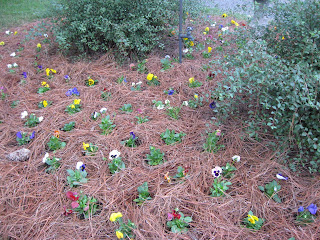Spring is Getting Closer!

There is still time to prepare yourself and your garden for spring.
If you haven't done it yet you need to get your last minute pruning done before the sap begins to rise in your beloved trees. Be sure that all of your pruning tools are sharp. Chewing the limbs or branches off with dull tools is not good for the tree and can damage the health of the tree in the long run. Hand pruning shears are best for young trees.

Make sure all of your perennials and ornamental grasses have been cut back and cleaned up. When the new growth emerges, it is not inhibited, and they can get off to a good start for the upcoming growing season.
Roses can be pruned back now if you haven't already done so. Most roses do not need aggressive pruning, just a gentle trim and removal of any dead branches or cutting back leggy parts.
Doing a final rake across the yard and around your trees and shrubs will improve the look of spring by a hundred percent.
Some people give in to the urge to mulch in the spring as it gives their landscape a fresher look. However, mulching in the fall is a better practice as it can protect your plants from the colder temperatures and it keeps your yard looking fresh when nothing else is. If you insist on mulching in the spring, be careful not to add too much to any existing mulch. It is best to keep your mulch layer to 3 inches or less. If you already have that much piled up, you may want to remove some of the old before putting down the new. However I would like to suggest that if you have a good bit of mulch down already, maybe you would be better off to just flip and stir the existing mulch to give it a fresher look. If you continue to pile on the mulch you are essentially putting your roots deeper and deeper under ground. For shallow rooters such as azaleas, this could be devastating.
 Long-leaf pine needles make a pretty alternative to mulch. Pine needles are best put down in winter after you have finished raking leaves. The best pine needles are found in winter or very early spring and have a red color.
Long-leaf pine needles make a pretty alternative to mulch. Pine needles are best put down in winter after you have finished raking leaves. The best pine needles are found in winter or very early spring and have a red color. My favorite part of the prep work is getting the soil ready. If the ground is workable and not waterlogged, you can get into your beds and cultivate the soil. Loosen it up and add your compost to replenish the nutrients. It is a good time to add some manure too, if you choose to do so. There is something very satisfying about turning the ground and smelling the earth. It is also time to add a slow release fertilizer to trees, shrubs, pansies, and perennials so that they can start the season off right.
My favorite part of the prep work is getting the soil ready. If the ground is workable and not waterlogged, you can get into your beds and cultivate the soil. Loosen it up and add your compost to replenish the nutrients. It is a good time to add some manure too, if you choose to do so. There is something very satisfying about turning the ground and smelling the earth. It is also time to add a slow release fertilizer to trees, shrubs, pansies, and perennials so that they can start the season off right.Don't forget! Any of the debris from clean up should be added back to your compost pile. Except of course, for any thing that may have been diseased. Come back later and we will share with you some valuable compost tips.
All of your hard work will pay off in the very near future when the birds are singing, the spring flowers break the ground, and mother nature allows us to see her in her full beauty once again.
















